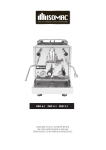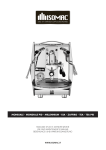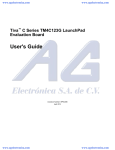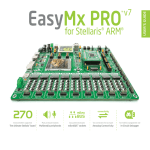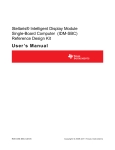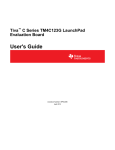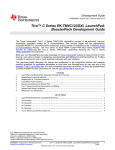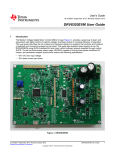Download Stellaris® MDL-LM4F211CNCD User`s Manual
Transcript
Stellaris® LM4F211 controlCARD Module (MDL-LM4F211CNCD) User Manual Literature Number: SPMU294A August 2012 – Revised December 2012 Contents 1 Stellaris® LM4F211 controlCARD Overview 1.1 1.2 1.3 ............................................................................ 4 MDL-LM4F211CNCD Kit Contents ....................................................................................... Compatibility Matrix ......................................................................................................... Using the LM4F211 controlCARD Module ............................................................................... 1.3.1 Features ............................................................................................................. 1.3.2 Board Dimensions ................................................................................................. 5 5 6 6 6 A .......................................................................................................... 7 2.1 Block Diagram ............................................................................................................... 7 2.2 Functional Description ...................................................................................................... 8 2.2.1 Microcontroller and Interfaces (Schematic Page 1) ........................................................... 8 2.2.2 Debug Interface, Virtual COM Port, and Isolators (Schematic Page 2) .................................... 9 Software Development ....................................................................................................... 11 3.1 Software Description ...................................................................................................... 11 3.2 Programming the MDL-LM4F211CNCD controlCARD Module ..................................................... 12 PCB Layout and References ............................................................................................... 13 4.1 Component Locations ..................................................................................................... 13 4.2 References ................................................................................................................. 13 Schematics ....................................................................................................................... 14 2 Contents 2 3 4 Hardware Description SPMU294A – August 2012 – Revised December 2012 Submit Documentation Feedback Copyright © 2012, Texas Instruments Incorporated www.ti.com List of Figures ............................................................................ 1-1. MDL-LM4F211CNCD controlCARD Module 2-1. Block Diagram ............................................................................................................... 7 4 2-2. controlCARD Module Isolation ........................................................................................... 10 2-3. Using controlCARD without a Baseboard .............................................................................. 10 4-1. Top-Side Component Location .......................................................................................... 13 List of Tables 1-1. Compatibility Matrix ......................................................................................................... 5 2-1. COM Port Pin Connections ................................................................................................ 9 SPMU294A – August 2012 – Revised December 2012 Submit Documentation Feedback Copyright © 2012, Texas Instruments Incorporated List of Figures 3 Chapter 1 SPMU294A – August 2012 – Revised December 2012 Stellaris® LM4F211 controlCARD Overview The Stellaris® LM4F211 controlCARD module is a DIMM form-factor evaluation board that can be used as a standalone module or with a range of baseboards to accelerate evaluation and development. Texas Instruments offers a range of controlCARD baseboards for motor and power-control applications. In most cases, these baseboards are available as complete kits that include a controlCARD module and a baseboard. The Stellaris MDL-LM4F211CNCD module is part of Texas Instruments’ controlCARD lineup that includes cards for Stellaris, C2000™, Hercules™, and MSP430™ devices. Not all controlCARD and baseboards configurations are supported. See the Compatibility Matrix for more information on baseboard options. The Stellaris LM4F211H5QR microcontroller is an ARM® Cortex™-M4F device with 256 KB Flash and operation at up to 80 MHz. Figure 1-1 shows a photo of the Stellaris MDL-LM4F211CNCD controlCARD module. Figure 1-1. MDL-LM4F211CNCD controlCARD Module C2000, Hercules, MSP430, Code Composer Studio are trademarks of Texas Instruments. Stellaris, StellarisWare are registered trademarks of Texas Instruments. Cortex is a trademark of ARM, Ltd. ARM, RealView are registered trademarks of ARM, Ltd. Sourcery CodeBench is a trademark of Mentor Graphics. Microsoft, Windows are registered trademarks of Microsoft Corporation. All other trademarks are the property of their respective owners. 4 Stellaris® LM4F211 controlCARD Overview SPMU294A – August 2012 – Revised December 2012 Submit Documentation Feedback Copyright © 2012, Texas Instruments Incorporated MDL-LM4F211CNCD Kit Contents www.ti.com 1.1 MDL-LM4F211CNCD Kit Contents The LM4F211 controlCARD module kit comes with the following items: • MDL-LM4F211CNCD controlCARD module – On-board Stellaris In-Circuit Debug Interface (ICDI) • Cables/Accessories – USB-miniB to USB-A plug cable (for debug and serial communication) – 1/2-inch (1.27 cm) jumper wires (for bridging power) • Development Kit CD – For the controlCARD module in standalone use: • Complete documentation • StellarisWare® Peripheral Driver Library and example source code – For the controlCARD module when used with a supported baseboard: • Source code and binaries • Documentation specific to each supported baseboard • GUI Microsoft® Windows®-based application • Tools CD – Texas Instruments’ Code Composer Studio™ Integrated Development Environment (IDE) – Other tool chains NOTE: The MDL-LM4F211CNCD board may be populated with an LM4F231H5QR microcontroller. This device contains a superset of the features of the LM4F4211H5QR microcontroller. There is no difference in functionality. 1.2 Compatibility Matrix Table 1-1 shows which baseboards are compatible with the MDL-LM4F211CNCD controlCARD module. Table 1-1. Compatibility Matrix Baseboard Description Electrical Compatibility? Supported with Software? Complete Kit Available? DRV8312 3-Phase, 6.5-A BLDC motor driver Yes Yes DK-LM4F-DRV8312 DRV8301 3-Phase BLDC motor pre-driver Yes No No SPMU294A – August 2012 – Revised December 2012 Submit Documentation Feedback Stellaris® LM4F211 controlCARD Overview Copyright © 2012, Texas Instruments Incorporated 5 Using the LM4F211 controlCARD Module 1.3 www.ti.com Using the LM4F211 controlCARD Module To start using the controlCARD module as a standalone module, see the MDL-LM4F211CNCD Read Me First document (included on the CD). To start using the controlCARD module in conjunction with a Texas Instruments’ controlCARD baseboard, see the Read Me First document specific to that platform. 1.3.1 Features The Stellaris MDL-LM4F211CNCD controlCARD module includes the following features: • LM4F211H5QR Stellaris microcontroller – 32-bit ARM Cortex-M4 floating point core – 80 MHz max speed – 256 KB Flash, 32 KB RAM • DIMM form-factor • GPIO signals available on DIMM edge-connector • User LED • Debug – Stellaris In-Circuit Debug Interface (ICDI) – Isolated to 300 V working voltage using Texas’ Instruments’ digital isolators 1.3.2 Board Dimensions The MDL-LM4F211CNCD board measures 3.55 in x 1.40 in (9.02 cm x 3.556 cm). See the Component Locations section for more details. Schematics Complete schematics for the MDL-LM4F211CNCD are appended to this document. 6 Stellaris® LM4F211 controlCARD Overview SPMU294A – August 2012 – Revised December 2012 Submit Documentation Feedback Copyright © 2012, Texas Instruments Incorporated Chapter 2 SPMU294A – August 2012 – Revised December 2012 Hardware Description In addition to an LM4F211H5QR microcontroller, the controlCARD module includes some simple multiplexing logic and an integrated Stellaris in-circuit debug interface (ICDI). This chapter describes how the hardware interfaces to the microcontroller. 2.1 Block Diagram Figure 2-1 shows the controlCARD module block diagram. Figure 2-1. Block Diagram 100 Pin DIMM-format Edge Connector Debug ISO Pwr +3.3V PWM0..5 PWM0..5 QEI QEI ADC[12] +5V Stellaris® LM4F211 Microcontroller User ADC0..11 LDO Regulator +3.3V SPI SSI CAN CAN GPIO[3] GPIO[3] UART JTAG 560Vpk working-voltage Isolation USB Stellaris® In-Circuit Debug Interface (LM3S3601) ISO+5V RSTn TMS TDI TCK RSTn TMS TDI TCK Digital Isolator Enable GND TDO RX_ISO TX_ISO LDO Regulator Digital Isolator TDO U0TX U0RX ISO +3.3V SPMU294A – August 2012 – Revised December 2012 Submit Documentation Feedback Copyright © 2012, Texas Instruments Incorporated Hardware Description 7 Functional Description 2.2 www.ti.com Functional Description This section provides a detailed description of the LM4F211 controlCARD module hardware. 2.2.1 Microcontroller and Interfaces (Schematic Page 1) LM4F211H5QR Microcontroller The Stellaris LM4F211H5QR microcontroller is an ARM Cortex-M4-based microcontroller with 256-KB flash memory, 32-KB SRAM, 80-MHz operation, motion control PWMs, controller area network (CAN), and a wide range of other peripherals. See the LM4F211H5QR microcontroller data sheet for complete device details. The LM4F211H5QR microcontroller is factory-programmed with a simple quickstart demo program. The quickstart program resides in on-chip Flash memory and runs each time power is applied, unless the quickstart has been replaced with a user program. DIMM Edge Connector Most of the Stellaris microcontroller GPIO signals are routed to the DIMM-style edge connector. The controlCARD module is compatible with standard DIMM sockets, such as Molex part number 87630-1001. User LED The board also has a green user LED connected to GPIO PG5. Signal Multiplexing The DRV8312 and DRV8301 baseboards have Hall inputs on different DIMM pins. U11 multiplexes these signals under the control of GPIO PB6. An analog switch (U12) under the control of PB4 selects between bus current (I-total) and Phase B current (IB-FB). See the associated ZIP file with a spreadsheet that details the signals for the module (available for download from the MDL-LM4F211CNCD tool folder on the TI website; click on the Technical Documents link). Reset The RESET signal into the LM4F211H5QR microcontroller connects to an R-C network (R1/C1) and to the ICDI circuit for a debugger-controlled reset. A voltage supervisor (U8) monitors the +5-V rail to ensure that the microcontroller is held in reset well before the +3.3-V supply rail moves below the –10% limit. External reset is asserted (active low) under any one of these conditions: • Power-on reset • By the ICDI circuit when instructed by the debugger (this capability is optional, and may not be supported by all debuggers). • By the +5-V voltage supervisor if the rail drops below +4.38 V. Power Supplies The controlCARD module is typically powered by the baseboards via the DIMM edge connector. When used as a standalone module, without a baseboard, install wire jumpers to support USB-powered operation. WARNING Do not install the wire power links if the controlCARD module is installed in a baseboard. Damage to the board may result. In highvoltage applications, the power supplies must remain electrically isolated for personal safety. 8 Hardware Description SPMU294A – August 2012 – Revised December 2012 Submit Documentation Feedback Copyright © 2012, Texas Instruments Incorporated Functional Description www.ti.com 2.2.2 Debug Interface, Virtual COM Port, and Isolators (Schematic Page 2) Stellaris In-Circuit Debug Interface (ICDI) and Virtual COM Port The MDL-LM4F211CNCD controlCARD module includes an onboard Stellaris In-Circuit Debug Interface (ICDI). The Stellaris ICDI allows for the programming and debug of the LM4F211H5QR microcontroller using LM Flash and/or any of the supported tool chains. The debug interface incorporates Texas Instruments’ digital isolators (ISO7240M and ISO7242M) for safety isolation between the ICDI and the Stellaris microcontroller. Due to the presence of the unidirectional isolators, only JTAG debugging and programming is supported. Serial Wire Debug (SWD) and Serial Wire Trace (SWT) are not supported. Virtual COM Port When plugged in to a PC, the device enumerates as a debugger and a virtual COM port. The COM port is connected to the following pins on the microcontroller as shown in Table 2-1. Table 2-1. COM Port Pin Connections GPIO Pin Pin Functions PA0 U0RX Virtual COM Port TXD PA1 U0TX RXD The UART signals are also electrically isolated. Electrical Isolation The PCB layout incorporates IEC standard reinforced isolation for over-voltage category II and pollution degree 2. Creepage and clearance distances are 6.4 mm. The digital isolators limit the working voltage to 560 Vpk, which is sufficient for most 115 Vrms and 230 Vrms line-powered designs. CAUTION If using the controlCARD as a module in a new design, refer to the safety regulations that apply to that product and its environment to determine the safe working voltage. The integrated isolation feature allows the Stellaris microcontroller to operate at the same common-mode voltage as the baseboards which simplifies circuit design in high-voltage motor control designs. Firmware programming, debugging, and serial communication is supported using the isolated, low-voltage debug interface. Figure 2-2 shows controlCARD module isolation. WARNING When installed in a high-voltage power board, the microcontroller and non-isolated circuitry may be at high voltage. Read and understand the safety warnings included in the power board documentation before using the controlCARD module in a highvoltage application. SPMU294A – August 2012 – Revised December 2012 Submit Documentation Feedback Copyright © 2012, Texas Instruments Incorporated Hardware Description 9 Functional Description www.ti.com Figure 2-2. controlCARD Module Isolation Isolation barrier Low-Voltage (Isolated) Side High-Voltage (Non-Isolated) Side NOTE: Non-isolated means that these circuits will be at the same voltage potential as the baseboard. The controlCARD module may be used without a baseboard. In order to power the non-isolated circuitry, power must be bridged across the isolation barrier as shown in Figure 2-3. WARNING Do not install the controlCARD module in a baseboard if the jumpers are installed. The isolation barrier is compromised and an electric shock hazard exists. Power-supply contention may also damage the controlCARD module or the baseboard. Figure 2-3. Using controlCARD without a Baseboard To bridge power, install 0.5" wire power-jumpers into J2 and J3 (both sides of PCB). Ensure that wires do not short to other components. Low-Voltage Side Low-Voltage Side WARNING: Do not install controlCARD in a baseboard when wire power-jumpers are installed! 10 Hardware Description SPMU294A – August 2012 – Revised December 2012 Submit Documentation Feedback Copyright © 2012, Texas Instruments Incorporated Chapter 3 SPMU294A – August 2012 – Revised December 2012 Software Development This chapter provides general information on software development as well as instructions for Flash memory programming. 3.1 Software Description The CD supplied with the controlCARD module includes the StellarisWare® Peripheral Driver Library which contains a rich set of functions for developing software for the Stellaris microcontroller and its onchip peripherals. The software includes a set of example applications that utilize the StellarisWare® Peripheral Driver Library. These applications demonstrate the capabilities of the LM4F211H5QR microcontroller, as well as providing a starting point for developing user applications. Source Code The complete source code is included on the controlCARD Development Kit CD. See the quickstart guide for the respective toolchain to get information on how to install the source code and toolchain. The source code and binary files are installed in the StellarisWare tree. Tool Options The source code installation includes directories containing projects and/or makefiles for the following toolchains: • Keil ARM RealView® Microcontroller Development System • IAR Embedded Workbench for ARM • Sourcery CodeBench™ • Code Red Technology Red Suite • Generic Gnu C compiler • Texas Instruments' Code Composer Studio IDE Baseboards from Texas Instruments may not support all toolchain options. Evaluation versions of these tools may be downloaded from www.ti.com/stellaris. Due to code size restrictions, the evaluation tools may not build all example programs. A full license is necessary to re-build or debug all examples. Instructions for installing and using each of the evaluation tools can be found in each toolchain quick-start guide (for example, Quickstart-Keil, Quickstart-IAR) which are available for download from the evaluation kit section of our web site at www.ti.com/stellaris. For detailed information on using the tools, see the documentation included in the toolchain installation or visit the website of the tool supplier. SPMU294A – August 2012 – Revised December 2012 Submit Documentation Feedback Copyright © 2012, Texas Instruments Incorporated Software Development 11 Programming the MDL-LM4F211CNCD controlCARD Module 3.2 www.ti.com Programming the MDL-LM4F211CNCD controlCARD Module The MDL-LM4F211CNCD software package includes pre-built binaries for each of the example applications. If you installed StellarisWare to the default installation path (C:\StellarisWare), you can find the example applications in C:\StellarisWare\boards\mdl-lm4f211cncd. The onboard Stellaris ICDI is used along with the Stellaris LM Flash Programmer tool to program applications on the MDL-LM4F211CNCD board. Follow these procedures to program example applications into the MDL-LM4F211CNCD evaluation board using the Stellaris ICDI: 1. Install LM Flash Programmer on a Windows-based PC. 2. Connect the USB cable A-plug to an available port on the PC and the miniB-plug to the board. 3. Verify that both power LEDs are lit. LED D2 indicates the status of the non-isolated microcontroller power and LED D1 indicates the status of the isolated USB power. 4. Run LM Flash Programmer. 5. In the Configuration tab, use the Quick Set control to select LM4F232 Evaluation Board. Move to the Program tab and click the Browse button. Navigate to the example applications directory (the default location is C:\StellarisWare\boards\MDL-LM4F211CNCD). 6. Each example application has its own directory. Navigate to the example directory that you want to load and then into the directory which contains the binary (*.bin) files. Select the binary file and click Open. 7. Set the Erase Method to Erase Necessary Pages, check the Verify After Program box, and check Reset MCU After Program. 8. Next, click the Program button to start the Erase, Download and Verify process. The DEBUG ACTIVE LED (D1) on the board turns on at this time. 9. Program execution starts once the Verify process is complete. 12 Software Development SPMU294A – August 2012 – Revised December 2012 Submit Documentation Feedback Copyright © 2012, Texas Instruments Incorporated Chapter 4 SPMU294A – August 2012 – Revised December 2012 PCB Layout and References 4.1 Component Locations Figure 4-1 shows the plot of the top-side component locations. Figure 4-1. Top-Side Component Location 4.2 References In addition to this document, the following references are included on the Stellaris controlCARD Development Kit CD and are also available for download from the TI website at www.ti.com: • Stellaris Development and Evaluation Kits for Code Composer Studio Quickstart Guide • Stellaris LM4F211H5QR Microcontroller Data Sheet (literature number SPMS323) • StellarisWare Driver Library User’s Manual, publication SW-DRL-UG (literature number SPMU019) • Associated ZIP file with a spreadsheet that summarizes the signals for the MDL-LM4F211CNCD (literature number SPMU294) Information on development tool being used: • Texas Instruments’ Code Composer Studio IDE website: www.ti.com/ccs SPMU294A – August 2012 – Revised December 2012 Submit Documentation Feedback Copyright © 2012, Texas Instruments Incorporated PCB Layout and References 13 Appendix A SPMU294A – August 2012 – Revised December 2012 Schematics The following schematics for the LM4F211 controlCARD module are appended to this document: • Stellaris Contents (sheet 1) • Debug Interface, Virtual COM Port, and Isolators (sheet 2) 14 Schematics SPMU294A – August 2012 – Revised December 2012 Submit Documentation Feedback Copyright © 2012, Texas Instruments Incorporated Stellaris Contents U1 17 18 19 20 21 22 23 24 PA0/CAN1RX PA1/CAN1TX PA2/SSI0CLK PA3/SSI0FSS PA4/SSI0RX PA5/SSI0TX PA6/M1PWM2 PA7/M1PWM3 U8 TLV803MDB +5.0V 3 VDD RST 1 RESET 2 52 51 50 49 16 15 14 13 TCK TMS TDI TDO PC4/M0PWM6 PC5 PC6/U3RX PC7/U3TX +4.38V Supervisor 9 8 7 6 59 60 PE0/AIN3 PE1/AIN2 PE2/AIN1 PE3/AIN0 PE4/AIN9 PE5/AIN8 GND D5 TARGETRST 1N4448HWS 40 41 38 R1 10K +3.3V PF0/M1PWM4 PF1/M1PWM5 PF2/M1PWM6 PF3/M1PWM7 PF4/IDX0 PE0/AIN3 PE1/AIN2 PE2/AIN1 PE3/AIN0 PE4/AIN9 PE5/AIN8 PG0/GPIO PG1/GPIO PG2/GPIO PG3/GPIO PG4/GPIO PG5/GPIO OSC0 OSC1 R2 2 RSTN VDDC VDDC C1 0.01UF 10PF VDDA/VREF 3 C18 3.3UF 61 62 63 64 43 44 53 10 28 29 30 31 5 37 36 35 34 33 32 56 25 VDDA 12 27 39 55 DIMM-style Edge Connector PB0/U1RX PB1/U1TX PB2/I2C0SCL PB3/I2S0SDA PB4/AIN10 PB5/AIN11 PB6/M0PWM0 PB7/T0CCP1 +5.0V DIMM100_TI_CNCD C33 3.3UF PD0/AIN7 PD1/AIN6 PD2/AIN5 PD3/AIN4 PD4 PD5/WT4CCP1 PD6/PHA0 PD7/PHB0 PB2/I2C0SCL PA1/CAN1TX PC7/U3TX PF4/IDX0 PD7/PHB0 PF0/M1PWM4 PF1/M1PWM5 PF2/M1PWM6 PF3/M1PWM7 PF4/IDX0 PA3/SSI0FSS PA4/SSI0RX PG1 PC5 PC4/M0PWM6 PB7/T0CCP1 PG0/T4CCP0 PG1 PG2/M1PWM0 PG3/M1PWM1 PG4 PG5 C2 3.3UF PD4 PF3/M1PWM7 PF1/M1PWM5 PA7/M1PWM3 PG3/M1PWM1 C11 0.1UF C13 0.01UF PD2/AIN5 PE4/AIN9 GNDA VDD VDD VDD VDD GND GND GND GND TP1 +3.0V LM4F211H5QR 42 26 11 54 +3.3V C10 0.1UF C12 0.1UF C14 0.01UF PE3/AIN0 C15 0.01UF PE1/AIN2 Reference +5.0V 2 1 3 4 VIN VOUT DNC1 TEMP NC DNC GND PE5/AIN8 Stellaris MCU U6 C19 3.3UF 45 46 47 48 58 57 1 4 OMIT C5 10PF PC0/TCK PD0/AIN7 PD1/AIN6 PC1/TMS PD2/AIN5 PC2/TDI PD3/AIN4 PC3/TDO PD4/WT4CCP0/U6RX PC4/M0PWM6 PC5/M0PWM7 PD5/WT4CCP1 PC6/U3RX PD6/PHA0 PD7/PHB0 PC7/U3TX +3.3V Y1 16MHz C4 PA0/CAN1RX PB0/U1RX PB1/U1TX PA1/CAN1TX PB2/I2C0SCL PA2/SSI0CLK PB3/I2C0SDA/GPIO PA3/GPIO PA4/SSI0RX PB4/AIN10 PB5/AIN11 PA5/SSI0TX PA6/M1PWM2 PB6/M0PWM0 PA7/M1PWM3 PB7/M0PWM1/T0CCP1 TRIMNR 6 7 8 5 REF5030ADGK 100 99 98 97 96 95 94 93 92 91 90 89 88 87 86 85 84 83 82 81 80 79 78 77 76 75 74 73 50 49 48 47 46 45 44 43 42 41 40 39 38 37 36 35 34 33 32 31 30 29 28 27 26 25 24 23 72 71 70 69 68 67 66 65 64 63 62 61 60 59 58 57 22 21 20 19 18 17 16 15 14 13 12 11 10 9 8 7 56 55 54 53 52 51 6 5 4 3 2 1 PB3/I2S0SDA PA0/CAN1RX PC6/U3RX PD6/PHA0 PA2/SSI0CLK PA5/SSI0TX PG5 PG4 PG0/T4CCP0 PD4 PD5/WT4CCP1 PB6/M0PWM0 PF2/M1PWM6 PF0/M1PWM4 PA6/M1PWM2 PG2/M1PWM0 PB4/AIN10 PD0/AIN7 PD3/AIN4 PE2/AIN1 PE0/AIN3 PD1/AIN6 X1 PB5/AIN11 User LED PG5 +3.3V 125mA +3.3V +5.0V U4 1 2 C3 3.3UF 3 IN OUT 5 GND EN NR D3 R9 Green 330 +3.3V C6 3.3UF 4 TPS73033DBV C8 0.01UF Power D2 R10 DESIGNER REVISION DATE Green 330 JAG A 4/20/2012 TEXAS INSTRUMENTS STELLARIS PROJECT R MICROCONTROLLERS 108 WILD BASIN ROAD, SUITE 350 Control Card LM4F211 AUSTIN TX, 78746 DESCRIPTION www.ti.com/stellaris STELLARIS LM4F211 CONTROLCARD WITH LM4F211H5QR MCU FILENAME MDL-LM4F211CNCD Rev A.sch PART NO. MDL-LM4F211CNCD SHEET 1 OF 2 Debug Interface, Virtual COM Port, and Isolators NON-ISOLATED MCU CIRCUIT ISOLATED DEBUG INTERFACE ICDI USB 14 13 12 11 TCK TMS TARGETRST TDI 9 15 VCC1 EN NC OUTA OUTB OUTC OUTD INA INB INC IND GND2A GND2B GND1A GND1B 1 U7 R13 10K 0.1UF 7 3 4 5 6 GND_ISO TCK_ISO TMS_ISO TARGETRST_ISO TDI_ISO 2 8 +3.3V_ISO +3.3V_ISO GND_ISO R6 10K ISO7240M R7 10K ICDI_TCK ICDI_TMS ICDI_TDI ICDI_TDO +3.3V 17 18 19 20 21 22 25 26 PA0/U0RX PA1/U0TX PA2/SSI0CLK PA3/SSI0FSS PA4/SSI0RX PA5/SSI0TX PA6/I2C1SCL PA7/I2C1SDA 52 51 50 49 11 14 15 16 PC0/TCK/SWCLK PC1/TMS/SWDIO PC2/TDI PC3/TDO/SWO PC4/CCP5 PC5/USB0EPEN PC6/USB0PFLT PC7/CCP4 +3.3V_ISO 6 5 2 1 8 U3 C23 +3.3V_ISO 16 0.1UF 10 14 13 12 11 PB0/U1RX PB1/U1TX TDO 9 15 VCC2 VCC1 EN2 EN1 OUTA OUTB INC IND INA INB OUTC OUTD GND2A GND2B GND1A GND1B 1 0.1UF 3 4 5 6 R8 10K C22 7 GND_ISO ICDI_RST TX_ISO RX_ISO TDO_ISO C31 0.1UF 2 8 ICDI JTAG GND_ISO GND_ISO GND_ISO J4 ISO7242M 6 7 8 9 10 5 4 3 2 1 ICDI_TCK ICDI_TMS ICDI_TDO ICDI_TDI ICDI_RST GND_ISO GND_ISO PE0/SSI1CLK PE1/SSI1FSS PE2/SSI1RX PE3/SSI1TX PE4/CCP3 40 RST_N 32 33 WAKE_N HIB_N 13 10 60 44 29 24 36 53 39 GND1 GND2 GND3 GND4 GND5 GND6 GND7 GND8 GND9 4 GNDA TC2050-IDC-NL PCB footprint only +3.3V_ISO D+ ID G R12 0 OHM 7 +3.3V_ISO PB0/CCP0 PB1/U1TX PB2/I2C0SCL PB3/I2C0SDA PB4/U1RX PB5/CCP2 PB6/CCP1 PB7/NMI 41 42 47 27 58 57 56 55 PD0/U2RX PD1/U2TX PD2/CCP6 PD3/CCP7 61 62 63 64 +5V_USB GND_ISO GND_ISO R4 49.9 ICDI STATUS C32 0.1UF D4 R3 GND_ISO 330 Green GND_ISO USB0DM USB0DP USB0RBIAS 45 46 48 OSC0 OSC1 30 31 XOSC0 XOSC1 34 35 VBAT 37 VDD1 VDD2 VDD3 VDD4 VDDA 28 12 59 43 3 VDD25_4 VDD25_3 VDD25_2 VDD25_1 54 38 23 9 LDO GND_ISO D- 5 VCC2 5V 4 10 CON-USB-MINI-B J1 6 3 16 0.1UF Stellaris In-Circuit Debug Interface (ICDI) +3.3V_ISO C20 2 U2 1 +3.3V_ISO +3.3V C21 R5 9.10K GND_ISO Y2 16MHz GND_ISO +3.3V_ISO C26 0.1UF GND_ISO C27 0.1UF GND_ISO C30 0.01UF C24 10PF C25 10PF GND_ISO GND_ISO GND_ISO 7 C17 3.3UF LM3S3601 C28 0.1UF C29 0.01UF ISO +3.3V Power R11 330 D1 GND_ISO GND_ISO GND_ISO Green GND_ISO +3.3V 125mA +5.0V +3.3V_ISO +5V_USB U5 J2 1 +5V_USB 1 2 2 C9 3.3UF 3 IN OUT 5 EN NR C16 3.3UF 4 J3 GND_ISO GND_ISO DATE A 4/20/2012 GND_ISO TEXAS INSTRUMENTS STELLARIS GND_ISO R MICROCONTROLLERS 108 WILD BASIN ROAD, SUITE 350 Control Card LM4F211 C7 0.01UF 2 REVISION JAG PROJECT TPS73033DBV 1 DESIGNER GND AUSTIN TX, 78746 GND_ISO DESCRIPTION www.ti.com/stellaris STELLARIS LM4F211 CONTROLCARD WITH LM4F211H5QR MCU FILENAME MDL-LM4F211CNCD Rev A.sch PART NO. MDL-LM4F211CNCD SHEET 2 OF 2 EVALUATION BOARD/KIT/MODULE (EVM) ADDITIONAL TERMS Texas Instruments (TI) provides the enclosed Evaluation Board/Kit/Module (EVM) under the following conditions: The user assumes all responsibility and liability for proper and safe handling of the goods. Further, the user indemnifies TI from all claims arising from the handling or use of the goods. Should this evaluation board/kit not meet the specifications indicated in the User’s Guide, the board/kit may be returned within 30 days from the date of delivery for a full refund. THE FOREGOING LIMITED WARRANTY IS THE EXCLUSIVE WARRANTY MADE BY SELLER TO BUYER AND IS IN LIEU OF ALL OTHER WARRANTIES, EXPRESSED, IMPLIED, OR STATUTORY, INCLUDING ANY WARRANTY OF MERCHANTABILITY OR FITNESS FOR ANY PARTICULAR PURPOSE. EXCEPT TO THE EXTENT OF THE INDEMNITY SET FORTH ABOVE, NEITHER PARTY SHALL BE LIABLE TO THE OTHER FOR ANY INDIRECT, SPECIAL, INCIDENTAL, OR CONSEQUENTIAL DAMAGES. Please read the User's Guide and, specifically, the Warnings and Restrictions notice in the User's Guide prior to handling the product. This notice contains important safety information about temperatures and voltages. For additional information on TI's environmental and/or safety programs, please visit www.ti.com/esh or contact TI. No license is granted under any patent right or other intellectual property right of TI covering or relating to any machine, process, or combination in which such TI products or services might be or are used. TI currently deals with a variety of customers for products, and therefore our arrangement with the user is not exclusive. TI assumes no liability for applications assistance, customer product design, software performance, or infringement of patents or services described herein. REGULATORY COMPLIANCE INFORMATION As noted in the EVM User’s Guide and/or EVM itself, this EVM and/or accompanying hardware may or may not be subject to the Federal Communications Commission (FCC) and Industry Canada (IC) rules. For EVMs not subject to the above rules, this evaluation board/kit/module is intended for use for ENGINEERING DEVELOPMENT, DEMONSTRATION OR EVALUATION PURPOSES ONLY and is not considered by TI to be a finished end product fit for general consumer use. It generates, uses, and can radiate radio frequency energy and has not been tested for compliance with the limits of computing devices pursuant to part 15 of FCC or ICES-003 rules, which are designed to provide reasonable protection against radio frequency interference. Operation of the equipment may cause interference with radio communications, in which case the user at his own expense will be required to take whatever measures may be required to correct this interference. General Statement for EVMs including a radio User Power/Frequency Use Obligations: This radio is intended for development/professional use only in legally allocated frequency and power limits. Any use of radio frequencies and/or power availability of this EVM and its development application(s) must comply with local laws governing radio spectrum allocation and power limits for this evaluation module. It is the user’s sole responsibility to only operate this radio in legally acceptable frequency space and within legally mandated power limitations. Any exceptions to this are strictly prohibited and unauthorized by Texas Instruments unless user has obtained appropriate experimental/development licenses from local regulatory authorities, which is responsibility of user including its acceptable authorization. For EVMs annotated as FCC – FEDERAL COMMUNICATIONS COMMISSION Part 15 Compliant Caution This device complies with part 15 of the FCC Rules. Operation is subject to the following two conditions: (1) This device may not cause harmful interference, and (2) this device must accept any interference received, including interference that may cause undesired operation. Changes or modifications not expressly approved by the party responsible for compliance could void the user's authority to operate the equipment. FCC Interference Statement for Class A EVM devices This equipment has been tested and found to comply with the limits for a Class A digital device, pursuant to part 15 of the FCC Rules. These limits are designed to provide reasonable protection against harmful interference when the equipment is operated in a commercial environment. This equipment generates, uses, and can radiate radio frequency energy and, if not installed and used in accordance with the instruction manual, may cause harmful interference to radio communications. Operation of this equipment in a residential area is likely to cause harmful interference in which case the user will be required to correct the interference at his own expense. FCC Interference Statement for Class B EVM devices This equipment has been tested and found to comply with the limits for a Class B digital device, pursuant to part 15 of the FCC Rules. These limits are designed to provide reasonable protection against harmful interference in a residential installation. This equipment generates, uses and can radiate radio frequency energy and, if not installed and used in accordance with the instructions, may cause harmful interference to radio communications. However, there is no guarantee that interference will not occur in a particular installation. If this equipment does cause harmful interference to radio or television reception, which can be determined by turning the equipment off and on, the user is encouraged to try to correct the interference by one or more of the following measures: • Reorient or relocate the receiving antenna. • Increase the separation between the equipment and receiver. • Connect the equipment into an outlet on a circuit different from that to which the receiver is connected. • Consult the dealer or an experienced radio/TV technician for help. For EVMs annotated as IC – INDUSTRY CANADA Compliant This Class A or B digital apparatus complies with Canadian ICES-003. Changes or modifications not expressly approved by the party responsible for compliance could void the user’s authority to operate the equipment. Concerning EVMs including radio transmitters This device complies with Industry Canada licence-exempt RSS standard(s). Operation is subject to the following two conditions: (1) this device may not cause interference, and (2) this device must accept any interference, including interference that may cause undesired operation of the device. Concerning EVMs including detachable antennas Under Industry Canada regulations, this radio transmitter may only operate using an antenna of a type and maximum (or lesser) gain approved for the transmitter by Industry Canada. To reduce potential radio interference to other users, the antenna type and its gain should be so chosen that the equivalent isotropically radiated power (e.i.r.p.) is not more than that necessary for successful communication. This radio transmitter has been approved by Industry Canada to operate with the antenna types listed in the user guide with the maximum permissible gain and required antenna impedance for each antenna type indicated. Antenna types not included in this list, having a gain greater than the maximum gain indicated for that type, are strictly prohibited for use with this device. Cet appareil numérique de la classe A ou B est conforme à la norme NMB-003 du Canada. Les changements ou les modifications pas expressément approuvés par la partie responsable de la conformité ont pu vider l’autorité de l'utilisateur pour actionner l'équipement. Concernant les EVMs avec appareils radio Le présent appareil est conforme aux CNR d'Industrie Canada applicables aux appareils radio exempts de licence. L'exploitation est autorisée aux deux conditions suivantes : (1) l'appareil ne doit pas produire de brouillage, et (2) l'utilisateur de l'appareil doit accepter tout brouillage radioélectrique subi, même si le brouillage est susceptible d'en compromettre le fonctionnement. Concernant les EVMs avec antennes détachables Conformément à la réglementation d'Industrie Canada, le présent émetteur radio peut fonctionner avec une antenne d'un type et d'un gain maximal (ou inférieur) approuvé pour l'émetteur par Industrie Canada. Dans le but de réduire les risques de brouillage radioélectrique à l'intention des autres utilisateurs, il faut choisir le type d'antenne et son gain de sorte que la puissance isotrope rayonnée équivalente (p.i.r.e.) ne dépasse pas l'intensité nécessaire à l'établissement d'une communication satisfaisante. Le présent émetteur radio a été approuvé par Industrie Canada pour fonctionner avec les types d'antenne énumérés dans le manuel d’usage et ayant un gain admissible maximal et l'impédance requise pour chaque type d'antenne. Les types d'antenne non inclus dans cette liste, ou dont le gain est supérieur au gain maximal indiqué, sont strictement interdits pour l'exploitation de l'émetteur. SPACER SPACER SPACER SPACER SPACER SPACER SPACER SPACER 【Important Notice for Users of this Product in Japan】 】 This development kit is NOT certified as Confirming to Technical Regulations of Radio Law of Japan If you use this product in Japan, you are required by Radio Law of Japan to follow the instructions below with respect to this product: 1. 2. 3. Use this product in a shielded room or any other test facility as defined in the notification #173 issued by Ministry of Internal Affairs and Communications on March 28, 2006, based on Sub-section 1.1 of Article 6 of the Ministry’s Rule for Enforcement of Radio Law of Japan, Use this product only after you obtained the license of Test Radio Station as provided in Radio Law of Japan with respect to this product, or Use of this product only after you obtained the Technical Regulations Conformity Certification as provided in Radio Law of Japan with respect to this product. Also, please do not transfer this product, unless you give the same notice above to the transferee. Please note that if you could not follow the instructions above, you will be subject to penalties of Radio Law of Japan. Texas Instruments Japan Limited (address) 24-1, Nishi-Shinjuku 6 chome, Shinjuku-ku, Tokyo, Japan http://www.tij.co.jp 【ご使用にあたっての注】 本開発キットは技術基準適合証明を受けておりません。 本製品のご使用に際しては、電波法遵守のため、以下のいずれかの措置を取っていただく必要がありますのでご注意ください。 1. 2. 3. 電波法施行規則第6条第1項第1号に基づく平成18年3月28日総務省告示第173号で定められた電波暗室等の試験設備でご使用いただく。 実験局の免許を取得後ご使用いただく。 技術基準適合証明を取得後ご使用いただく。 なお、本製品は、上記の「ご使用にあたっての注意」を譲渡先、移転先に通知しない限り、譲渡、移転できないものとします。 上記を遵守頂けない場合は、電波法の罰則が適用される可能性があることをご留意ください。 日本テキサス・インスツルメンツ株式会社 東京都新宿区西新宿6丁目24番1号 西新宿三井ビル http://www.tij.co.jp SPACER SPACER SPACER SPACER SPACER SPACER SPACER SPACER SPACER SPACER SPACER SPACER SPACER SPACER SPACER SPACER EVALUATION BOARD/KIT/MODULE (EVM) WARNINGS, RESTRICTIONS AND DISCLAIMERS For Feasibility Evaluation Only, in Laboratory/Development Environments. Unless otherwise indicated, this EVM is not a finished electrical equipment and not intended for consumer use. It is intended solely for use for preliminary feasibility evaluation in laboratory/development environments by technically qualified electronics experts who are familiar with the dangers and application risks associated with handling electrical mechanical components, systems and subsystems. It should not be used as all or part of a finished end product. Your Sole Responsibility and Risk. You acknowledge, represent and agree that: 1. 2. 3. 4. You have unique knowledge concerning Federal, State and local regulatory requirements (including but not limited to Food and Drug Administration regulations, if applicable) which relate to your products and which relate to your use (and/or that of your employees, affiliates, contractors or designees) of the EVM for evaluation, testing and other purposes. You have full and exclusive responsibility to assure the safety and compliance of your products with all such laws and other applicable regulatory requirements, and also to assure the safety of any activities to be conducted by you and/or your employees, affiliates, contractors or designees, using the EVM. Further, you are responsible to assure that any interfaces (electronic and/or mechanical) between the EVM and any human body are designed with suitable isolation and means to safely limit accessible leakage currents to minimize the risk of electrical shock hazard. You will employ reasonable safeguards to ensure that your use of the EVM will not result in any property damage, injury or death, even if the EVM should fail to perform as described or expected. You will take care of proper disposal and recycling of the EVM’s electronic components and packing materials. Certain Instructions. It is important to operate this EVM within TI’s recommended specifications and environmental considerations per the user guidelines. Exceeding the specified EVM ratings (including but not limited to input and output voltage, current, power, and environmental ranges) may cause property damage, personal injury or death. If there are questions concerning these ratings please contact a TI field representative prior to connecting interface electronics including input power and intended loads. Any loads applied outside of the specified output range may result in unintended and/or inaccurate operation and/or possible permanent damage to the EVM and/or interface electronics. Please consult the EVM User's Guide prior to connecting any load to the EVM output. If there is uncertainty as to the load specification, please contact a TI field representative. During normal operation, some circuit components may have case temperatures greater than 60°C as long as the input and output are maintained at a normal ambient operating temperature. These components include but are not limited to linear regulators, switching transistors, pass transistors, and current sense resistors which can be identified using the EVM schematic located in the EVM User's Guide. When placing measurement probes near these devices during normal operation, please be aware that these devices may be very warm to the touch. As with all electronic evaluation tools, only qualified personnel knowledgeable in electronic measurement and diagnostics normally found in development environments should use these EVMs. Agreement to Defend, Indemnify and Hold Harmless. You agree to defend, indemnify and hold TI, its licensors and their representatives harmless from and against any and all claims, damages, losses, expenses, costs and liabilities (collectively, "Claims") arising out of or in connection with any use of the EVM that is not in accordance with the terms of the agreement. This obligation shall apply whether Claims arise under law of tort or contract or any other legal theory, and even if the EVM fails to perform as described or expected. Safety-Critical or Life-Critical Applications. If you intend to evaluate the components for possible use in safety critical applications (such as life support) where a failure of the TI product would reasonably be expected to cause severe personal injury or death, such as devices which are classified as FDA Class III or similar classification, then you must specifically notify TI of such intent and enter into a separate Assurance and Indemnity Agreement. Mailing Address: Texas Instruments, Post Office Box 655303, Dallas, Texas 75265 Copyright © 2012, Texas Instruments Incorporated IMPORTANT NOTICE Texas Instruments Incorporated and its subsidiaries (TI) reserve the right to make corrections, enhancements, improvements and other changes to its semiconductor products and services per JESD46, latest issue, and to discontinue any product or service per JESD48, latest issue. Buyers should obtain the latest relevant information before placing orders and should verify that such information is current and complete. All semiconductor products (also referred to herein as “components”) are sold subject to TI’s terms and conditions of sale supplied at the time of order acknowledgment. TI warrants performance of its components to the specifications applicable at the time of sale, in accordance with the warranty in TI’s terms and conditions of sale of semiconductor products. Testing and other quality control techniques are used to the extent TI deems necessary to support this warranty. Except where mandated by applicable law, testing of all parameters of each component is not necessarily performed. TI assumes no liability for applications assistance or the design of Buyers’ products. Buyers are responsible for their products and applications using TI components. To minimize the risks associated with Buyers’ products and applications, Buyers should provide adequate design and operating safeguards. TI does not warrant or represent that any license, either express or implied, is granted under any patent right, copyright, mask work right, or other intellectual property right relating to any combination, machine, or process in which TI components or services are used. Information published by TI regarding third-party products or services does not constitute a license to use such products or services or a warranty or endorsement thereof. Use of such information may require a license from a third party under the patents or other intellectual property of the third party, or a license from TI under the patents or other intellectual property of TI. Reproduction of significant portions of TI information in TI data books or data sheets is permissible only if reproduction is without alteration and is accompanied by all associated warranties, conditions, limitations, and notices. TI is not responsible or liable for such altered documentation. Information of third parties may be subject to additional restrictions. Resale of TI components or services with statements different from or beyond the parameters stated by TI for that component or service voids all express and any implied warranties for the associated TI component or service and is an unfair and deceptive business practice. TI is not responsible or liable for any such statements. Buyer acknowledges and agrees that it is solely responsible for compliance with all legal, regulatory and safety-related requirements concerning its products, and any use of TI components in its applications, notwithstanding any applications-related information or support that may be provided by TI. Buyer represents and agrees that it has all the necessary expertise to create and implement safeguards which anticipate dangerous consequences of failures, monitor failures and their consequences, lessen the likelihood of failures that might cause harm and take appropriate remedial actions. Buyer will fully indemnify TI and its representatives against any damages arising out of the use of any TI components in safety-critical applications. In some cases, TI components may be promoted specifically to facilitate safety-related applications. With such components, TI’s goal is to help enable customers to design and create their own end-product solutions that meet applicable functional safety standards and requirements. Nonetheless, such components are subject to these terms. No TI components are authorized for use in FDA Class III (or similar life-critical medical equipment) unless authorized officers of the parties have executed a special agreement specifically governing such use. Only those TI components which TI has specifically designated as military grade or “enhanced plastic” are designed and intended for use in military/aerospace applications or environments. Buyer acknowledges and agrees that any military or aerospace use of TI components which have not been so designated is solely at the Buyer's risk, and that Buyer is solely responsible for compliance with all legal and regulatory requirements in connection with such use. TI has specifically designated certain components as meeting ISO/TS16949 requirements, mainly for automotive use. In any case of use of non-designated products, TI will not be responsible for any failure to meet ISO/TS16949. Products Applications Audio www.ti.com/audio Automotive and Transportation www.ti.com/automotive Amplifiers amplifier.ti.com Communications and Telecom www.ti.com/communications Data Converters dataconverter.ti.com Computers and Peripherals www.ti.com/computers DLP® Products www.dlp.com Consumer Electronics www.ti.com/consumer-apps DSP dsp.ti.com Energy and Lighting www.ti.com/energy Clocks and Timers www.ti.com/clocks Industrial www.ti.com/industrial Interface interface.ti.com Medical www.ti.com/medical Logic logic.ti.com Security www.ti.com/security Power Mgmt power.ti.com Space, Avionics and Defense www.ti.com/space-avionics-defense Microcontrollers microcontroller.ti.com Video and Imaging www.ti.com/video RFID www.ti-rfid.com OMAP Applications Processors www.ti.com/omap TI E2E Community e2e.ti.com Wireless Connectivity www.ti.com/wirelessconnectivity Mailing Address: Texas Instruments, Post Office Box 655303, Dallas, Texas 75265 Copyright © 2012, Texas Instruments Incorporated





















